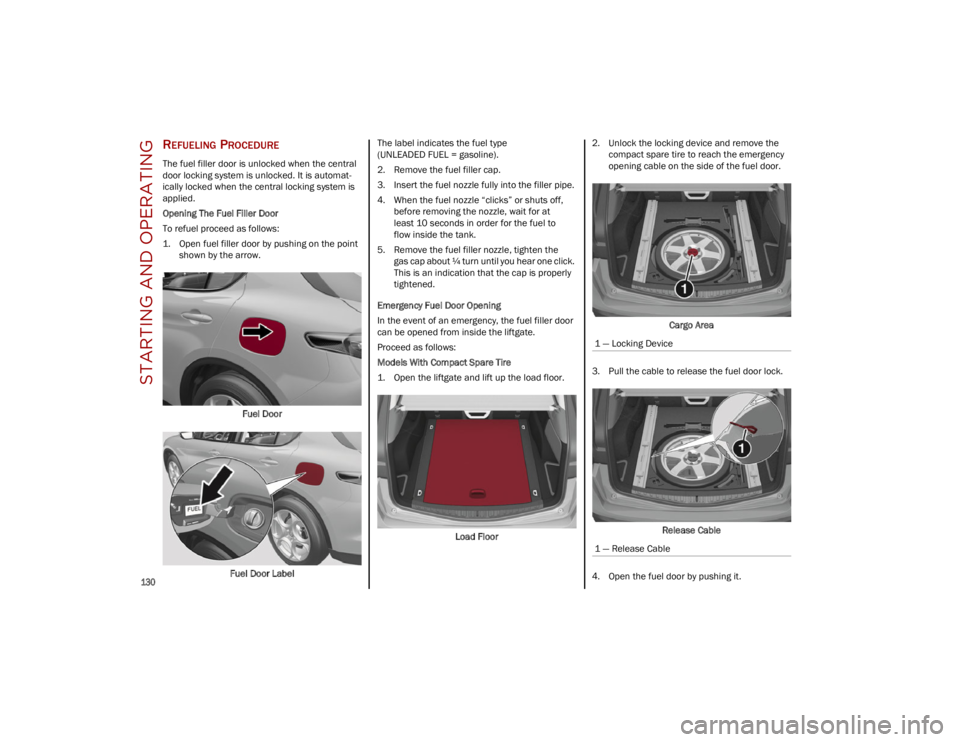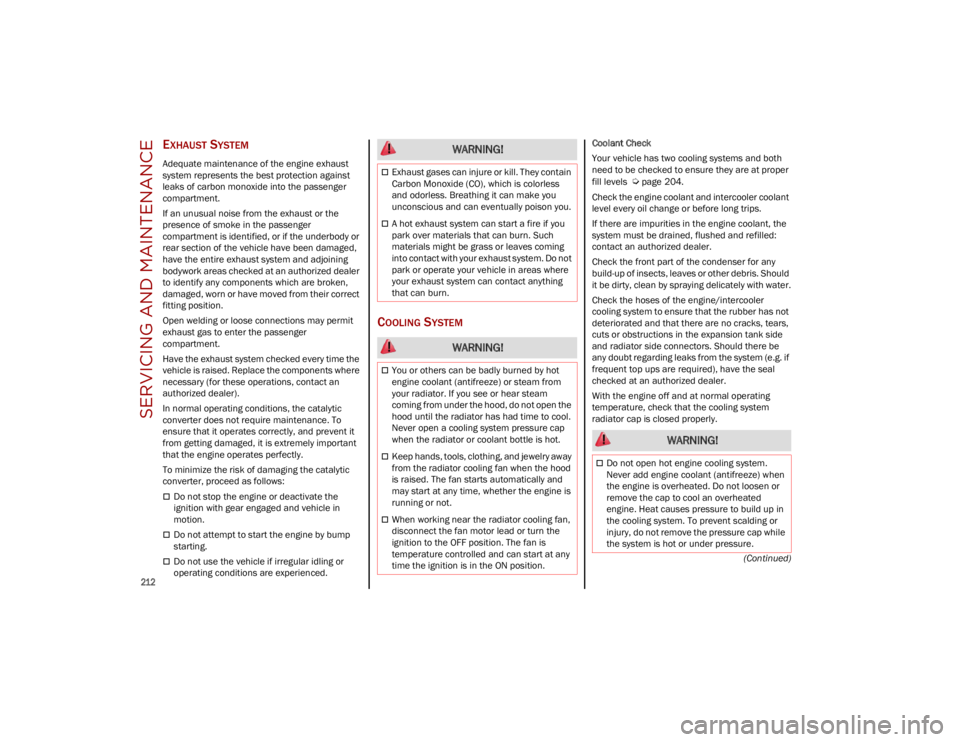2023 ALFA ROMEO STELVIO open gas tank
[x] Cancel search: open gas tankPage 132 of 268

STARTING AND OPERATING
130
REFUELING PROCEDURE
The fuel filler door is unlocked when the central
door locking system is unlocked. It is automat-
ically locked when the central locking system is
applied.
Opening The Fuel Filler Door
To refuel proceed as follows:
1. Open fuel filler door by pushing on the point shown by the arrow.
Fuel Door
Fuel Door Label The label indicates the fuel type
(UNLEADED FUEL = gasoline).
2. Remove the fuel filler cap.
3. Insert the fuel nozzle fully into the filler pipe.
4. When the fuel nozzle “clicks” or shuts off,
before removing the nozzle, wait for at
least 10 seconds in order for the fuel to
flow inside the tank.
5. Remove the fuel filler nozzle, tighten the gas cap about ¼ turn until you hear one click.
This is an indication that the cap is properly
tightened.
Emergency Fuel Door Opening
In the event of an emergency, the fuel filler door
can be opened from inside the liftgate.
Proceed as follows:
Models With Compact Spare Tire
1. Open the liftgate and lift up the load floor.
Load Floor 2. Unlock the locking device and remove the
compact spare tire to reach the emergency
opening cable on the side of the fuel door.
Cargo Area
3. Pull the cable to release the fuel door lock.
Release Cable
4. Open the fuel door by pushing it.
1 — Locking Device
1 — Release Cable
23_GU_OM_EN_USC_t.book Page 130
Page 133 of 268

131
Models Without Compact Spare Tire
1. Open the liftgate and lift up the load floor.Load Floor
2. Lift up the cover to reach the emergency opening cable on the side of the fuel door.
Cargo Box 3. Pull the cable to release the fuel door lock.
Cargo Box Opened
4. Open the fuel door by pushing it.
NOTE:
If the filler compartment is washed with a pres -
sure washer, keep it at a distance of at least
8 inches (20 cm).
1 — Cover
2 — Release Cable
WARNING!
Never have any smoking materials lit in or
near the vehicle when the fuel door is open
or the tank is being filled.
Never add fuel when the engine is running.
This is in violation of most state and federal
fire regulations and may cause the
Malfunction Indicator Lamp (MIL) to turn on.
A fire may result if gasoline is pumped into a
portable container that is inside of a vehicle.
You could be burned. Always place gas
containers on the ground while filling.
CAUTION!
To avoid fuel spillage and overfilling, do not
“top off” the fuel tank after filling.
23_GU_OM_EN_USC_t.book Page 131
Page 214 of 268

SERVICING AND MAINTENANCE
212
(Continued)
EXHAUST SYSTEM
Adequate maintenance of the engine exhaust
system represents the best protection against
leaks of carbon monoxide into the passenger
compartment.
If an unusual noise from the exhaust or the
presence of smoke in the passenger
compartment is identified, or if the underbody or
rear section of the vehicle have been damaged,
have the entire exhaust system and adjoining
bodywork areas checked at an authorized dealer
to identify any components which are broken,
damaged, worn or have moved from their correct
fitting position.
Open welding or loose connections may permit
exhaust gas to enter the passenger
compartment.
Have the exhaust system checked every time the
vehicle is raised. Replace the components where
necessary (for these operations, contact an
authorized dealer).
In normal operating conditions, the catalytic
converter does not require maintenance. To
ensure that it operates correctly, and prevent it
from getting damaged, it is extremely important
that the engine operates perfectly.
To minimize the risk of damaging the catalytic
converter, proceed as follows:
Do not stop the engine or deactivate the
ignition with gear engaged and vehicle in
motion.
Do not attempt to start the engine by bump
starting.
Do not use the vehicle if irregular idling or
operating conditions are experienced.
COOLING SYSTEM
Coolant Check
Your vehicle has two cooling systems and both
need to be checked to ensure they are at proper
fill levels
Ú
page 204.
Check the engine coolant and intercooler coolant
level every oil change or before long trips.
If there are impurities in the engine coolant, the
system must be drained, flushed and refilled:
contact an authorized dealer.
Check the front part of the condenser for any
build-up of insects, leaves or other debris. Should
it be dirty, clean by spraying delicately with water.
Check the hoses of the engine/intercooler
cooling system to ensure that the rubber has not
deteriorated and that there are no cracks, tears,
cuts or obstructions in the expansion tank side
and radiator side connectors. Should there be
any doubt regarding leaks from the system (e.g. if
frequent top ups are required), have the seal
checked at an authorized dealer.
With the engine off and at normal operating
temperature, check that the cooling system
radiator cap is closed properly.
WARNING!
Exhaust gases can injure or kill. They contain
Carbon Monoxide (CO), which is colorless
and odorless. Breathing it can make you
unconscious and can eventually poison you.
A hot exhaust system can start a fire if you
park over materials that can burn. Such
materials might be grass or leaves coming
into contact with your exhaust system. Do not
park or operate your vehicle in areas where
your exhaust system can contact anything
that can burn.
WARNING!
You or others can be badly burned by hot
engine coolant (antifreeze) or steam from
your radiator. If you see or hear steam
coming from under the hood, do not open the
hood until the radiator has had time to cool.
Never open a cooling system pressure cap
when the radiator or coolant bottle is hot.
Keep hands, tools, clothing, and jewelry away
from the radiator cooling fan when the hood
is raised. The fan starts automatically and
may start at any time, whether the engine is
running or not.
When working near the radiator cooling fan,
disconnect the fan motor lead or turn the
ignition to the OFF position. The fan is
temperature controlled and can start at any
time the ignition is in the ON position.
WARNING!
Do not open hot engine cooling system.
Never add engine coolant (antifreeze) when
the engine is overheated. Do not loosen or
remove the cap to cool an overheated
engine. Heat causes pressure to build up in
the cooling system. To prevent scalding or
injury, do not remove the pressure cap while
the system is hot or under pressure.
23_GU_OM_EN_USC_t.book Page 212
Page 263 of 268

261
Door Locks .................................................... 28Automatic ................................................. 28
Door Opener, Garage ................................... 40
Doors............................................................. 25
Drive Train Control (DTC) System ..............141
Driving Modes .............................................. 97
Dynamic Steering Torque (DST) System ... 141
E
Electric Park Brake....................................... 89
Electric Remote Mirrors ............................... 38
Electronic Speed Control
(Cruise Control) ..........................................102
Electronic Stability Control (ESC)
System ........................................................141
Electronic Throttle Control Warning
Light .............................................................. 79
Emergency In Case Of ......................................183, 189
SOS Emergency Call .............................. 183
Emergency, In Case Of Jump Starting .........................................192
Overheating ............................................ 195
Towing.....................................................197
Emission Control System Maintenance...... 85
Engine ......................................................... 242 Block Heater............................................. 88
Engine Coolant Level .............................206
Exhaust Gas Caution .............................182
Fuel Requirements ................................ 249Jump Starting .........................................194
Oil ............................................................251
Oil Selection ...........................................251
Overheating ............................................ 195
Starting ................................................... 195 Engine Compartment ................................ 204
Engine Compartment (Washing) .............. 239
Engine Oil
Level Check ........................................... 205
Enhanced Accident Response
Feature .............................................. 168, 198
Ethanol ....................................................... 249
Exhaust Gas Cautions ............................... 182
Exhaust System ......................................... 182
Exterior Lighting ..................................... 43, 44
Exterior Lights ...................................... 43, 182
F
Flashers Hazard Warning ..................................... 183
Turn Signals .............................. 45, 78, 182
Fluid Capacities ......................................... 251
Fluid Leaks ................................................. 182
Fluids And Lubricants................................ 252
Fog Lights, Rear ............................................45
Forward Collision Warning ........................ 151
Fuel Additives ................................................ 250
Clean Air................................................. 249
Ethanol ................................................... 249
Light ..........................................................82
Materials Added .................................... 250
Methanol................................................ 249
Tank Capacity ........................................ 251
G
Garage Door Opener (HomeLink) ................40
Gasoline, Clean Air .................................... 249
Gasoline, Reformulated ............................ 249
Gross Axle Weight Rating .......................... 133 Gross Vehicle Weight Rating ..................... 133
GVWR .......................................................... 132
H
Hands-Free Liftgate ..................................... 64
Hazard Warning Flashers .......................... 183
Head Restraints ........................................... 36
Head Rests ................................................... 36
Headlights
Switch .................................................43, 44
Headlights (Cleaning) ................................ 239
Heated Mirrors ............................................. 39
Heated Seats ............................................... 35
Heated Steering Wheel ............................... 30
Heater, Engine Block ................................... 88
Highway Assist System .............................. 111
Hill Decent Control (HDC) System............. 142
Hill Start Assist (HSA) System ................... 143
Hitches Trailer Towing......................................... 134
HomeLink (Garage Door Opener) ............... 40
Hood Closing ...................................................... 62Opening .................................................... 62
I
Ignition .......................................................... 22 Switch ....................................................... 22
Immobilizer (Sentry Key) ............................. 21
In Case Of Emergency ............................... 183
Installing Electrical/Electronic Devices ......... 4
Instrument Cluster ....................................... 68 Descriptions ................................ 69, 70, 78
Display ...................................................... 70Reconfigurable Display ........................... 70
23_GU_OM_EN_USC_t.book Page 261